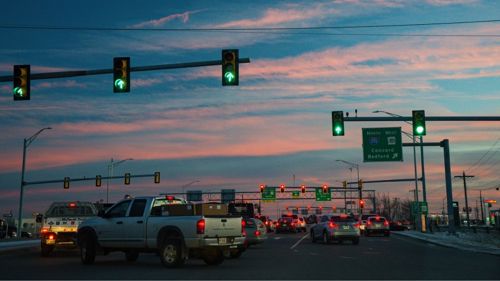The familiar traffic jams in urban regions are more than mere daily annoyances; they carry a hefty tag of environmental and economic repercussions.
For instance, the Global Traffic Scorecard reveals some eye-popping figures, with cities like London and Chicago witnessing traffic delay times stretching to 156 and 164 hours, respectively.

Over in 2022, drivers found themselves languishing in traffic for longer hours during peak times compared to 2021, hinting at a rebound to pre-pandemic rush-hour levels.
With 390 cities across 56 countries on the radar, the TomTom Traffic Index paints a detailed picture of the traffic scenario, linking prolonged travel time, ballooning fuel costs, and escalating CO2 emissions to the throbbing vein of urban traffic.
These statistics underline a pressing need for innovative solutions to untangle the gridlock, cut down on emissions, and steer urban mobility onto a sustainable lane.
Enter Google's Green Light Project. It aims to harness artificial intelligence (AI) to tackle traffic congestion and the resultant emissions. This innovative venture utilises the data captured by Google Maps, combined with machine learning, to optimise the timing of traffic signals at city intersections. Here’s a deeper dive into how this project is making waves in urban sustainability.
AI: driving change

Google's Green Light employs AI to scrutinise traffic patterns and structures at various intersections. By analysing this data, it provides recommendations for tweaking traffic light timings, contributing to smoother traffic flow and reduced waiting times. This system can be implemented by city engineers within minutes, without the need for additional infrastructure, making it a cost-effective solution for better urban traffic management.
Global impact
From its initial pilot in four Israeli intersections, the Green Light project has expanded to 12 cities globally, including notable cities like Rio de Janeiro, Manchester, and Jakarta. The implementation has led to a 20 per cent reduction in fuel use and delays at intersections, demonstrating its tangible benefits. Moreover, Google plans to broaden the project’s reach in 2024, promising a wider impact in the coming years.
The Green Light project directly addresses the environmental concern of emissions from road transport at city intersections, where pollution levels can be up to 29 times higher compared to open roads. The system aims to cut down one gigaton of carbon emissions by the end of this decade. The results from Manchester have already shown an 18 per cent improvement in emission levels and air quality, affirming the project’s positive environmental impact.
Google's initiative resonates well in the realm of sustainable urban planning, marking a significant step towards leveraging technology for environmental sustainability. By optimizing traffic light timings, the Green Light project not only improves traffic flow but also contributes to lowering greenhouse gas emissions significantly. This project is a testament to how AI and data analytics can be employed to address real-world challenges, creating a ripple effect towards achieving greener urban landscapes.
With the Green Light project, Google has managed to blend technological innovation with ecological responsibility, steering towards a future where city streets are less congested, and the air is cleaner.





